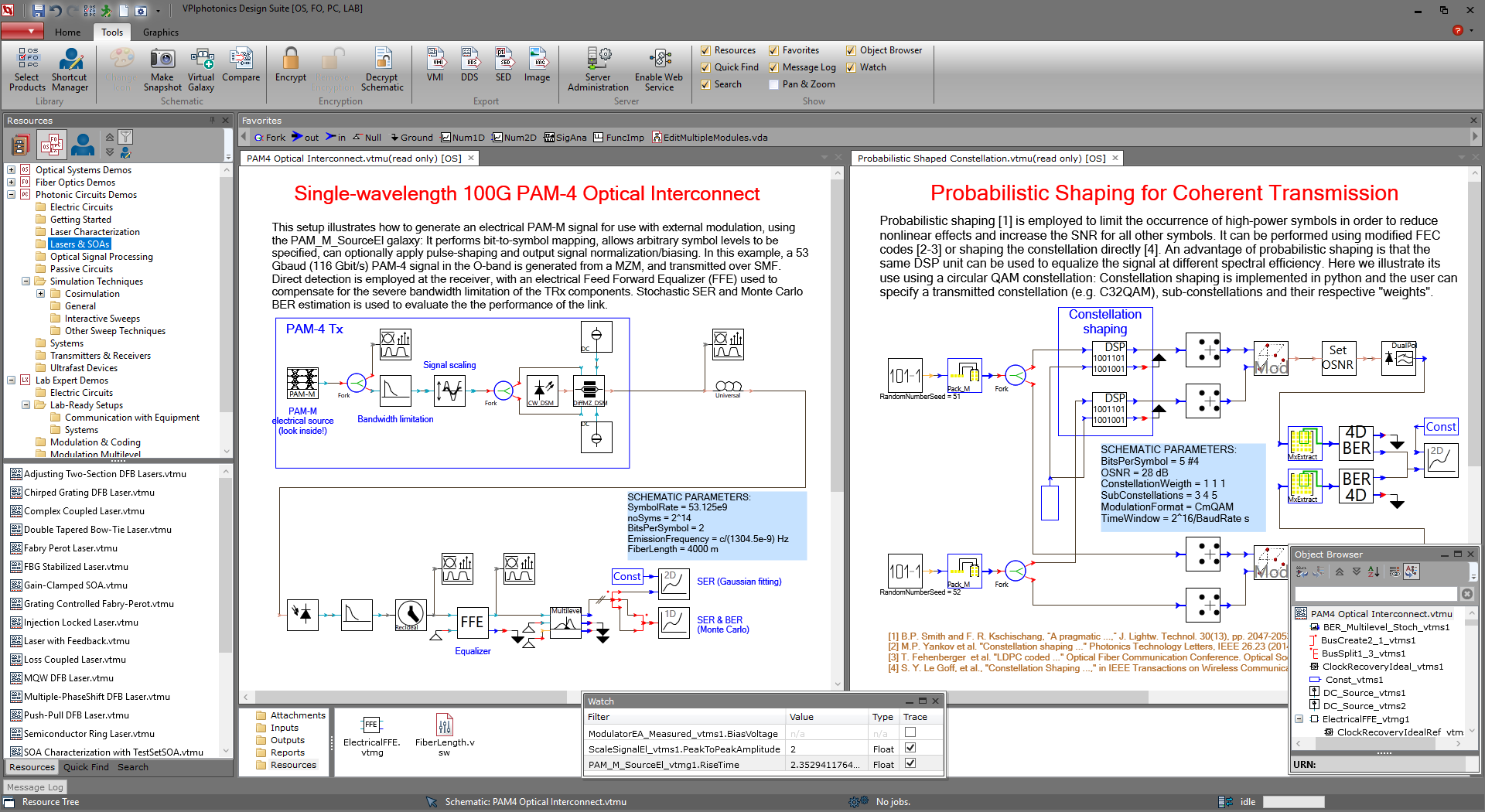VPIphotonics Design Suite Version 9.9 provides access to professional application-specific simulation tools and several pluggable toolkit extensions with common usability, design process and data analysis capabilities.
Among the new features in Version9.9 are enhancements of the user interface and tools operation, as well as advances in simulation capabilities comprising new design and analysis tools for coherent mQAM and direct-detection PAM-M systems, new and enhanced DSP and coding functionalities, extended library of PIC elements and instrumentation modules, and many more.
VPIphotonics' software solutions are utilized by numerous commercial companies and educational institutions for winning and successfully performing a diversity of research and design projects. With the improved capabilities provided in Version 9.9, VPIphotonics Design Suite continuously supports its existing and addresses even new applications and markets

Photonic Design Environment (PDE) of Version 9.9
Probabilistically-shaped mQAM – new module that uses Maxwell-Boltzmann distribution to shape constellation amplitudes and allows user-defined, non-integer bit-loading
High-multilevel mQAM – simplified mQAM signal generation from library for up to 4096 constellation points; arbitrary formats by user-defined mapping files are supported as before
Symbol Sequence Generator – new module supporting the generation of pseudo-random symbol sequences of adjustable alphabet length for multi-level modulation formats
BER with blind search – new method for BER estimation assuming a repetitive bit pattern in the transmitted signal; operates without reference bit sequence
Nonlinear Volterra filter – new DSP functionality supporting Volterra series filtering for modeling frequency-dependent nonlinearities of electrical components
Time-domain MIMO equalizer – enhanced set up in Multi-Modulus Algorithm (MMA) mode with pre-set modulation formats; added option to initialize tap coefficients to matched filter response
ML-CPR – new Maximum-Likelihood (ML) carrier phase recovery (CPR) algorithm that can operate in decision-directed or data-aided modes
Differential encoding – mitigation of cycle-slips using differential encoding available for common mQAM constellations and user-definable for arbitrary rotationally-symmetric constellations
Automated configuration of circuits – new macros enabling easy configuration of photonic circuits schematics for time- and frequency-domain simulations
Automated characterization – new macros and instrumentation modules enabling easy characterization of passive sub-circuits and active building blocks (lasers, SOAs, optical amplitude or phase modulators)
Faster simulation – greatly improved speed of time-domain simulations for passive sub-circuits with long group delays and for the dynamically tunable WaveguideModulator
Passive building blocks – new simplified models for passive components (waveguides, star couplers, MMIs) to enable fast initial circuit design before PIC technology is chosen
Electrical PAM-M signal generation – new dedicated module supporting pulse-shaping and arbitrary bit-to-level mapping;
suitable for driving any optical modulator or DML
TDECQ for PAM-4 – new analysis solution of Transmitter and Dispersion Eye Closure Quaternary (TDECQ) performance for PAM-4 transmitters; can be applied on experimental waveforms as well
Linear scaling of electrical signals – new module that can apply various linear amplitude scaling mechanisms to one or multiple electrical signals
Raised cosine pulses – two new normalization types for the Pulse Raised Cosine QAM module preserving the signal energy, or providing unity gain for the passband
Multimode VCSEL – new multimode VCSEL model for short-haul applications supporting inhomogeneous field- and carrier spatial distributions, thermal dynamics, chirping, noise, electrical parasitics
Multimode fiber – enhanced mode solver accounting for dispersion slope by fitting spectral dependence of propagation constant by up to 5th order polynomials
Compact multimode modules – simplified creation of schematics processing multimode signals by applying single-mode building blocks for each of the spatial modes with enhanced mapping block
Polarization scrambler – new model to perform deterministic or stochastic polarization scrambling; operates in periodic and aperiodic boundary conditions, with multiple runs and iterations
Nonlinear interference noise – new application illustrating how to isolate nonlinear interference noise (NLIN) in DWDM coherent optical systems
Show 2D cross-sections of 3D plots – use VPIphotonicsAnalyzer to visualize only interesting two-dimensional cross-sections of three-dimensional plots
Support of multiple GPUs – efficiently utilize multiple GPUs for simultaneously running GPU-assisted simulation jobs or during parameter sweeps executed in multitasking mode
Evaluation of parameters – parameter values in not fully connected schematics can be evaluated now simplifying the use of our rich parameter expressions capabilities
Many new demonstrations have been added and existing ones modified to illustrate new functions and applications. Version 9.9 provides access to over 850 ready-to-run demonstrations now.
This setup demonstrates the use of the Volterra series filter to model nonlinear electrical components. The conventional approach to emulating nonlinearity
(e.g. compression in modulator drivers), is to use a static transfer function. However, real components exhibit nonlinearity that is frequency-dependent.
Here, experimentally-obtained input-output waveforms from a real driver amplifier are used to determine the coefficients of a Volterra filter that more
accurately models the component. Simulated PAM-4 and PAM-8 signals are then passed through the model; compression is clearly observed as the input swing is
increased. The resulting nonlinear electrical signals can be fed to any optical modulator to produce realistic transmitter behavior.